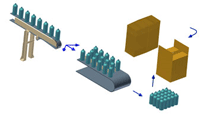 End of line automation such as case packing systems is a fairly important part of keeping up as a manufacturer in today’s world. With the right system, you can make sure that there are no holdups in production and that product can roll smoothly out of your manufacturing floor and onto shipping trucks so that they can reach your customers and the mass market.
End of line automation such as case packing systems is a fairly important part of keeping up as a manufacturer in today’s world. With the right system, you can make sure that there are no holdups in production and that product can roll smoothly out of your manufacturing floor and onto shipping trucks so that they can reach your customers and the mass market.
In this blog post, we’ll talk about the broad categories of case packing solutions by their load method so that you’ll have a good idea of what kind of system would best suit your needs.
Top Load Case Packing
A top load case packing system works by placing your product into the open top of an RSC. These systems are among the most widely-used automated case packing machine types on the market, being considered standard for many industries.
These systems can typically handle around 30 cases per minute, with excellent versatility in loading both flexible and rigid products into regular slotted containers, display trays, or even die cut wraparound package formats.
These systems come in both modular varieties, wherein separate stations are used for case/tray setup, product collation/loading, and final case sealing, as well as “single cell” variants that encompass all of these functions in a single machine, which helps you save valuable floor space for product storage or other equipment.
Heavy customization is the usual drawback to this system, as there needs to be an automated loading system specifically optimized for your particular product.
Side Load Case Packing
The fastest case packing systems are typically side-load case packing systems. These systems excel at quickly loading products from the side using a continuous motion format that prevents product bottlenecks, which keeps the production line rolling smoothly.
How fast are side-load systems? Some of these automated packing systems can achieve speeds in excess of 75 cases per minute.
In most cases, these machines use a one piece die-cut wraparound case style and hot glue sealing. As the speed of the machine rises, so too does the cost and complexity of the machine. In recent years, however, servo technology has become the standard, as it is not only the most precise and repeatable method for motion control on the line, the cost of servo technology has decreased.
For large manufacturers who have high-scale, high-volume production, side-load packing automation is often the ideal solution.
As with top-loading solutions, the heaviest amount of customization in a side load case packing machine is typically found in the product infeed and conditioning areas of the system.
Drop Case Packing
Typically considered perfectly suited for packing glass, hard plastics, and composite containers, drop case packing is incredibly cost effective upfront when compared to similar top-loading case packing solutions.
So, if this solution is more cost-effective, why is it limited primarily to use in the beverage industry, having been largely replaced with top load case packing systems in recent years?
There are two factors that contribute to this:
- Drop Case Packing is Considered “Old” Technology. These systems rely on gravity to load containers, whereas a top load case packer uses a more controlled approach that helps to ensure smooth loading operations.
- Maintenance Requirements. While less expensive initially, drop case systems typically require more maintenance than more modern systems do, increasing their cost over time.
If you’re trying to choose between a top load case packing system and a drop case packer, consider balancing the short term investment against the long term costs. The drop case system will be cheaper upfront, but the top load case packer will require less maintenance investment over time.
Bottom Load Case Packing
With maximum speeds of about 15 cases per minute, bottom load case packing systems are not the fastest of the end of line automation solutions on the market. This lower speed can be attributed to the fact that the entire case load has to be collected and collated in advance of the case actually being prepared and placed above the product load. Other methods assemble the case first, and load products as soon as they’re readied.
However, for some manufacturers, this type of packing automation may still be a desirable solution.
Why? Because, bottom load case packing tends to be very gentle on products, making it ideal for packing things such as glass bottles and other delicate items. Other solutions which might be capable of higher speeds might incidentally cause damage to especially fragile objects.
Ultimately, the type of case packing solution that you choose will be dictated by your product’s needs, your budget, and how quickly you need to process things at the end of the line to avoid a production bottleneck.
Learn more about case & tray forming in our free whitepaper at the link below:




